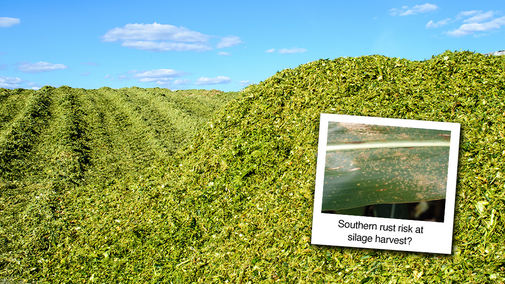Southern Rust and Silage Quality
Southern rust has been moving quickly across the region this summer under warm, wet conditions, raising grower concerns for corn silage.
Dr. Shelby Gruss, assistant professor and forage extension specialist with Iowa State University, noted that while southern rust itself doesn’t produce toxins, it can weaken plants and set the stage for stalk and ear rots like Fusarium and Gibberella. These rots may produce harmful mycotoxins that impact feed safety.
Another issue is rapid dry down. Southern rust pustules rupture the leaf surface, making it hard for the plant to regulate water. As plants mature, that damage accelerates dry down. Putting up silage too dry can limit packing, which impacts fermentation, stability and final quality.
A final concern is overall quality. Research shows southern rust pressure can increase fiber and drop digestibility by more than 10% — leaving less energy available for livestock even when yield looks decent. In heavily infected fields, yield losses may also reduce the portion of grain in the silage, lowering starch content and energy in the final product.
If you’re worried about feed quality, testing is a smart step. Pull a sample at harvest for an estimated value and again at feed out for a true feed value. If field scouting raises concerns about mycotoxins, testing is available, but keep in mind not all labs provide mycotoxin tests and the analysis can be expensive.
Southern rust is a concern this year, but careful harvest timing and feed testing can go a long way toward limiting its impact.
Testing Hay Quality
Do you know the quality of the hay that you harvested this past season? It is important to know how much protein and energy your cows will get when you start feeding, or how much supplement to feed. This may be especially important if your hay crop was affected by rain, drought or significant delays in harvest.
Maybe the most important step in sampling hay is deciding which bales and stacks should be included in each sample. Ideally, each sample should include only bales that were produced under similar conditions.
Obviously, the place to start grouping is to separate different types of hay, like alfalfa or CRP or cornstalk or meadow hay. But each cutting of hay probably is different from the other cuttings also, so there is another separation. And no two fields or meadows are ever exactly the same, especially if they were cut more than several days apart — this makes another grouping. And what if part of the field was rained on before it was baled? The hay made without rain damage will likely be different from hay with rain damage.
After you’ve made all these separations, which could result in quite a few groups of similar bales, then and only then are you ready to sample. From each group, gather a dozen or more cores from different bales or stacks and combine them into one sample. Be sure to use a good hay probe that can core into at least 12-18 inches into the bale.
Finally, send these samples to a certified lab for tests of crude protein and energy content. Testing any annual forages for nitrates is also a good idea.
Then use this information to feed your cattle as profitably as possible.
Fall Armyworm
In areas of eastern and south-central Nebraska, we have received reports of significant damage to fields from fall armyworm. Currently, infestations have been confirmed in the following Nebraska counties: Adams, Douglas, Gage, Harlan, Lancaster, Sarpy and Washington. It is likely present in other counties as well and will continue to cause feeding damage as long as warmer weather holds out. For this reason, scouting is highly recommended.
Fall armyworm caterpillars can be identified by markings on the head that resemble an inverted “Y” and four spots on the last abdominal segment that form a square. This insect does not overwinter in Nebraska but rather migrates north from southern states when populations build up in late summer. Once caterpillars are ¾-inch, they can do considerable damage in a few days. It is important to scout fields and pastures in the early morning and late afternoon, when caterpillars are most active, to spot them when they are small.
A reasonable treatment threshold is finding three or more caterpillars per square foot within a field or pasture. There are several insecticides labeled to control this insect including Mustang Maxx, Intrepid and Prevathon. For forage crops, be sure to check the grazing restriction and post-harvest interval. When considering a chemical treatment option, keep in mind that caterpillars ¾-inch or longer are close to maturity and can be harder to control.
Fall armyworm feeding declines with cooler temperatures and the adult moths eventually migrate south. In the meantime, keep a close eye on your pastures and newly seeded fields for any sign of infestation.

